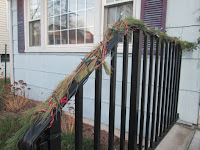Yesterday, I attended the Citizens' Climate Lobby's fall conference via Zoom. (Matter of fact, the conference is still going on today, with seminars on topics from the climate features of the budget reconciliation bill to a panel discussion between left-leaning and right-leaning CCL members — because yes, there actually are folks concerned about climate on the right, not that you'll ever find any of them in Washington. But I decided one day in front of my screen was enough for me.)
I spent the whole afternoon listening to talks about strategies for making progress on climate change, by the keynote address by Ayana Elizabeth Johnson (marine biologist and co-host of the How To Save a Planet podcast) to the closing remarks by CCL president Madeline Para. That's four solid hours of talks. And I can honestly say that by the end of the day, I knew a few useful things that I didn't know before.
Now, I'm about to teach you those same few useful things in a blog post that I imagine will take you far less than four hours to read. Here are my top takeaways from the conference — the most interesting, useful, inspiring, and "actionable" points of the whole day.
1. Regenerative ocean farming is a big deal.
The top question Dr. Johnson got asked at the end of her keynote was about the potential of regenerative ocean farming. I had heard a bit about this already in an episode of Freakonomics about the potential for raising food in the oceans. The guy he talked to, Bren Smith, is an aquaculture farmer who raises clams, oysters, mussels, and kelp: all "things that don't swim, that you don't have to feed." You can do all this on long lines that hang below the surface of the water, so they don't interfere with the view the way, say, an offshore wind farm does.
And apparently, their potential is enormous. Smith says you can grow 10 tons of kelp in one acre of ocean. This is not only a huge amount of food, but also a huge carbon sink. He cites a World Bank study saying that if you turned less than 5 percent of all U.S. waters over to seaweed farming, you could sequester "the carbon-output
equivalent of 20 million cars." And the portion of that seaweed that isn't suitable for food can be turned into fertilizer for land-based farming, reducing the need for synthetic fertilizers involved in the release of nitrous oxide (a greenhouse gas 300 times as powerful as carbon dioxide).
According to Dr. Johnson, this could be a pretty major piece of the solution to the climate-change puzzle. And the beauty part is, there's really no downside. Oysters and seaweed are delicious, so getting more of our food supply from them is all to the good.
2. The world isn't divided into climate change "believers" and "deniers."
One of yesterday's speakers was from the Yale Program on Climate Change Communication. It has come up with a model it calls "Six Americas" to visualize how Americans really feel about climate change. We fall into six groups:
- 26% of the population is Alarmed. These are the people, like me, who think that climate change is a true crisis and we as a species need to be doing a lot more about it than we are now. This is the group that's grown the most over time as major problems, like the California wildfires, have been in the news more and more.
- 29% are Concerned. These folks think climate change is a problem, all right, and we should definitely do something about it, but it doesn't need to be our top priority.
- 19% are Cautious. They're not 100% convinced yet of the science on climate change: whether it's happening at all, whether it's caused by human activity, and how big a problem it is. This group has shrunk the most in the face of the growing evidence on climate.
- 6% are Disengaged. They don't know much of anything about global warming, and they don't care.
- 12% are Doubtful. They incline to the view that global warming is either not happening or not a real problem.
- Only 8% are Dismissive. These are the folks you see screaming on the Internet about climate change being a hoax. They're a small minority of the population, but they get all the attention.
There's not much point in trying to talk to Dismissive folks about this issue. Their minds are made up, and they refuse to let you confuse them with facts. But it's possible to influence others if you go about it the right way.
3. The right way to talk about it is not to hammer people with facts.
This comes from speaker Katherine Hayhoe, a leading climate scientist who has addressed our group before. One of the fascinating things about her is that she's also an evangelical Christian, and she sees no contradiction whatsoever between these two things. And because she's talked to so many of her fellow evangelicals and others in the "doubtful" group about climate, she's learned that it does no good to throw a lot of facts at them to prove their views are wrong. Doing this just makes them dig in their heels and hold tighter to what they already believe.
Her approach? Start not with what you disagree on, but with what you have in common. Start with, "Look, you and I are both (Christians, moms, gardeners, whatever," and go on from there to, "And so we both believe (that God made us stewards of the earth, that we want to leave a better world for our children, that soil health is important...)." And once you've established that common ground, then lead into how that ties into climate. People are more willing to listen when you can frame the issue with something that's already important to them.
4. You can build your own solution to climate change, right now.
The single most fascinating thing I discovered at the conference was En-ROADS, an interactive climate simulator from Climate Interactive and the MIT Sloan Sustainability Initiative. It has all kinds of sliders you can adjust to see how different policies will affect the climate. The best thing about this is that it can show you, right on your computer screen, that climate action is not hopeless. You can sit there and play with the various levers and see for yourself that is is indeed possible, with the right policies, to keep global warming down to 1.5°C.
I attended a breakout session on how to use this tool, and our group came very close to hitting this target with just a handful of policies:
- A carbon price that starts at $15 per ton and rises to $850 per ton over 58 years
- Building and energy efficiency improvements of 3.5% per year
- 100% electrification of road and rail travel (coupled with a greener energy grid powered by renewables, which can be achieved through the carbon fee)
- Eliminating emissions of methane and other potent greenhouse gases
- "Medium growth" of technological carbon drawdown solutions — essentially, machines removing carbon from the atmosphere
With just these five changes, our group got global warming down to 1.6°C, as compared to the 3.6°C of warming (!) we can expect if we continue on our current course. Mind you, knowing what to do isn't the same as being able to do it, and getting leaders to take meaningful action is by far the hardest part (as we saw this week in Glasgow). But by proving that a solution — indeed, multiple solutions — are possible, this tool offers an antidote to climate despair. So rather than throwing up our hands and declaring the whole thing hopeless, we can roll up our sleeves and start pushing for the actions we know will work. And better still, we can see which actions work the best, so we know where to push.
5. Fun (?) fact: Fossil fuel subsides are bigger than the Pentagon's entire budget.
Yes, you heard that right. In 2017, our government spent more subsiding coal, oil, and gas production ($649 billion, counting both direct and indirect subsidies) than it budgeted for defense ($639 billion). And since climate change is probably the biggest threat to our national safety, we are effectively paying more to promote threats against our country than to protect ourselves from them.
6. To get letters to the editor published, you have to hunt for opportunities.
Most papers will only publish a letter to the editor if it's a direct response to a recently published story. So if you want to get your letters into the paper, you have to read the paper every day, looking for stories you could respond to with, "This just proves how much we need action on climate." Unfortunately, the only paper I currently read regularly is the New York Times, which has a very large circulation and thus is notoriously hard to get a letter published in. (I've only achieved it once, and that was on the topic of grammar.) So I guess if I want to make any progress in this area, I'll need to subscribe to more papers, and make the time to read them regularly.
7. I have the right to vote today thanks to Harry Burn's mom.
This final fact comes from the closing remarks by Madeline Para. To illustrate how one person can really make a difference on a big issue, she told the story of how the passage of the 19th Amendment, extending the franchise to women, came down to a single vote in the Tennessee House of Representatives. The deciding vote was cast by Harry Burn, who had voted against ratification twice before under pressure from anti-suffragists. But on the eve of the third vote, he received a long letter from his mother urging him to "be a good boy" and vote for suffrage. And the next day, he stood up in the House with that letter in his hand and voted yes, making Tennessee the last state needed to pass the 19th Amendment into law.
I don't have a son in state government, so maybe I can't have as momentous an effect as this. But I'll keep using what I do have — this blog, social media, conversations with friends, calls to Congress, and any letter I can manage to get into any paper — to exert as much leverage as I can toward pushing our climate, and the future of our species, back from the brink.



















